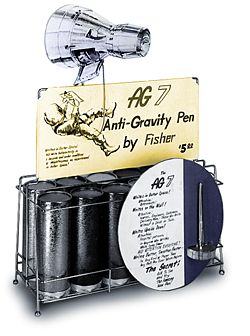The Fisher Space Pen
When I told my boss I was thinking about buying a Fisher Space Pen to replace the swanky black chrome model I lost about 14 years ago, he recalled the apocryphal tale of two space programs: one which spent a million dollars to engineer a pen that wrote in zero gravity and another, which relied on pencils, that old-school zero gravity writing implement. Those practical Soviets.
Days later, after said boss purchased his own Space Pen in a covert ops-ready matte black, he alerted me to an article called The Billion-Dollar Space Pen that he found on The Space Review, an online forum for writing about space exploration.
Turns out -- if we're to believe The Space Review … I'm suddenly nervously aware of the Internet's tendency toward bullshit -- there is some truth to the Space Pen urban (galactic?) legend: in 1963, "several newspapers reported that the mission would carry two pencils that cost $128.84 apiece. NASA had spent $4,382.50 to purchase 34 of the pencils."
Why? "The pencils were made of lightweight, high strength materials that could be attached to the inside of the spacecraft. The pencil housings had been expanded so that the astronauts could use them while wearing their bulky spacesuit gloves. The writing mechanism inside the housing had been procured from a local office supply house and had cost $1.75 each."
The Fisher Space pen was designed and funded privately by Mr. Paul Fisher. He asked NASA to endorse it and approve ad copy about it, but they didn't. But NASA was already planning to use Fisher's AG-7 pen on a future mission.

Fisher's website gives the clean version of the story, focusing on the AG-7.
The Space Review article, written by Dwayne A. Day, has in-text links to NASA documents about the Space Pen. Day's conclusion:
Days later, after said boss purchased his own Space Pen in a covert ops-ready matte black, he alerted me to an article called The Billion-Dollar Space Pen that he found on The Space Review, an online forum for writing about space exploration.
Turns out -- if we're to believe The Space Review … I'm suddenly nervously aware of the Internet's tendency toward bullshit -- there is some truth to the Space Pen urban (galactic?) legend: in 1963, "several newspapers reported that the mission would carry two pencils that cost $128.84 apiece. NASA had spent $4,382.50 to purchase 34 of the pencils."
Why? "The pencils were made of lightweight, high strength materials that could be attached to the inside of the spacecraft. The pencil housings had been expanded so that the astronauts could use them while wearing their bulky spacesuit gloves. The writing mechanism inside the housing had been procured from a local office supply house and had cost $1.75 each."
The Fisher Space pen was designed and funded privately by Mr. Paul Fisher. He asked NASA to endorse it and approve ad copy about it, but they didn't. But NASA was already planning to use Fisher's AG-7 pen on a future mission.

Fisher's website gives the clean version of the story, focusing on the AG-7.
The Space Review article, written by Dwayne A. Day, has in-text links to NASA documents about the Space Pen. Day's conclusion:
"The Million Dollar Space Pen Myth is just that, a myth. The pens never cost a lot of money and were not developed by wasteful bureaucrats or overactive NASA engineers. The real story of the Space Pen is less interesting than the myth, but in many ways more inspiring. It is not a story of NASA bureaucrats versus simplistic Russians, but a story of a clever capitalist who built a superior product and conducted some innovative marketing. That story, however, is a little harder to sell to a public that believes what it wants to believe."


0 Comments:
Post a Comment
<< Home